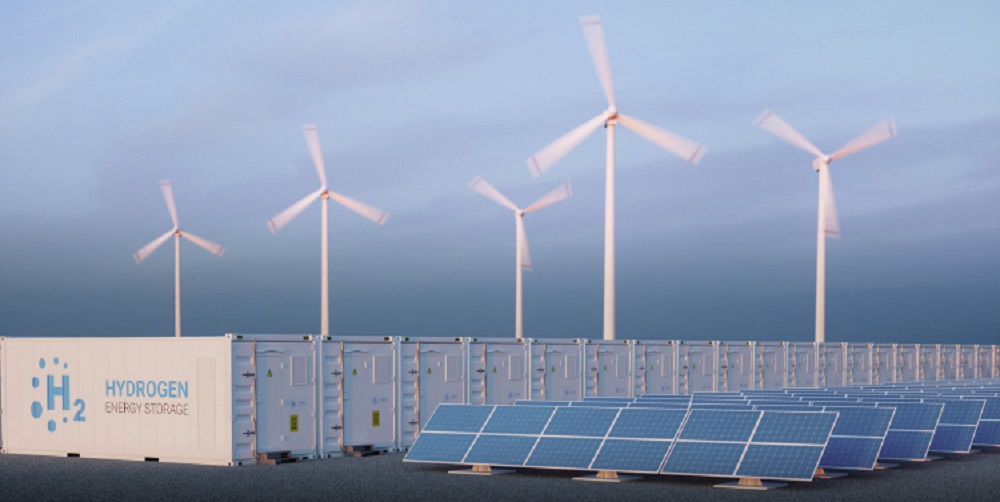Hydrogen power comes with quite a resume. The International Energy Agency (IEA) called hydrogen one of the “biggest innovation opportunities” for driving carbon dioxide emission reductions by 2050. The Inflation Reduction Act of 2022 made significant investments in clean energy including $369 billion investment in climate and energy policies. Many specifically for hydrogen production and use. Goldman Sachs named hydrogen as “the ultimate decarbonization tool.” By 2030, the hydrogen industry could account for $140 billion in revenue and 70,000 jobs. By 2050, it is expected that hydrogen could generate $750 billion in revenue and 3.4 million jobs.
But that does not mean hydrogen is poised to knock off—or even compete with—solar and wind. Instead, if done correctly, hydrogen might help drive further adoption of wind and solar.
Without diving too deep into the science behind hydrogen production, understand that it takes energy to produce hydrogen, with one of the most popular methods using water and electricity. When the electricity comes from a renewable source like wind, solar, hydroelectric or geothermal, green hydrogen is produced—with virtually all facets carbon free.
It’s only natural, then, to understand that as hydrogen grows in use, solar and wind energy can benefit as well. That’s why we believe we are better as collaborators—not competitors. But, to be true allies, everyone must play their part in promoting safe hydrogen production, distribution, transportation and storage.
Growing together
A hydrogen-based economy can fuel power generation, air transport, shipping, mobility and infrastructure. Already hydrogen fuel cells are becoming more accepted in vehicles, with more than 7,500 hydrogen fuel cell vehicles currently on the road. More than 25,000 hydrogen fuel cell material handling units—like forklifts and buses—are in use. While currently more expensive than gasoline, hydrogen is expected to reach parity with gasoline prices by 2025.
There are other uses as well. Earlier this year, a drone manufacturer introduced a hydrogen-powered drone for commercial and defense use, including emergency response, last-mile delivering and long-range intelligence gathering missions. Industrial applications include food production, aerospace, laboratories, and chemical production.
Still, typical hydrogen production relies on fossil fuels—negating any potential climate benefits as an alternative fuel. According to U.S. Department of Energy data from 2020, 99% of hydrogen production in the U.S. uses fossil fuels. Globally, about 76% of hydrogen uses fossil fuels in its production.
While there are huge possibilities, hurdles remain. Currently, hydrogen production using solar and wind is among the most costly production methods. The U.S. Department of Energy put the cost of wind electrolysis at $5.96 per kilogram of production. Solar electrolysis tops $8.00/kg.
Seeing the potential in Clean H2, the Department of Energy announced in late 2022 that it would issue $750 million in funding to accelerate the development of clean H2, producing hydrogen with net-zero carbon emissions. Renewables, nuclear energy and natural gas with carbon sequestration are all up for funding.
Safety: Mutual self interest
Bought into the idea of the potential but concerned about safety? That’s a valid issue—and one that the Compressed Gas Association (CGA) shares. As more and more newcomers see the potential in hydrogen and enter the market, we’re concerned that shortcuts might be taken.
We believe in treating hydrogen—and any other industrial gas—with respect. That means setting standards and following protocols, something CGA has been doing for more than 110 years.
We’ve recently launched the Safe Hydrogen Project to drive development of this game-changing energy source—while protecting those who are involved in its production, distribution and use. CGA also launched a CGA Hydrogen Membership, ensuring that perspectives from all segments of the hydrogen economy are represented as we continue to publish safety standards for this rapidly expanding industry.
Solar plants or wind facilities that supply a hydrogen facility can work with CGA to ensure that hydrogen producers do so in a safe manner by following CGA standards. CGA currently has standards that apply to the production, transportation, storage and use.
We welcome the interest of many newcomers to the market, but we want all of us to be safe. Any hydrogen incident has the potential to set the industry back decades—and potentially slow adoption of this critical technology.
That is our ultimate goal: to drive development of this new fuel while ensuring that everyone does so safely—and we need the wind and solar industries to be our partners. CGA itself is made up of many companies devoted to one common purpose: safety. We invite the solar and wind industries to see the opportunities in hydrogen—and to join us in ensuring that we can realize its potential without harming the environment or its users.

Paul Pflieger is director of marketing and communications for the Compressed Gas Association. Founded in 1913, the Compressed Gas Association (CGA) is dedicated to the development and promotion of safety standards and safe practices in the industrial, medical, and food gases industry.
The views and opinions expressed in this article are the author’s own, and do not necessarily reflect those held by pv magazine.
This content is protected by copyright and may not be reused. If you want to cooperate with us and would like to reuse some of our content, please contact: editors@pv-magazine.com.








By submitting this form you agree to pv magazine using your data for the purposes of publishing your comment.
Your personal data will only be disclosed or otherwise transmitted to third parties for the purposes of spam filtering or if this is necessary for technical maintenance of the website. Any other transfer to third parties will not take place unless this is justified on the basis of applicable data protection regulations or if pv magazine is legally obliged to do so.
You may revoke this consent at any time with effect for the future, in which case your personal data will be deleted immediately. Otherwise, your data will be deleted if pv magazine has processed your request or the purpose of data storage is fulfilled.
Further information on data privacy can be found in our Data Protection Policy.